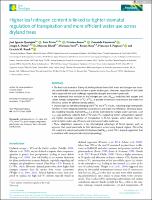| dc.contributor.author | Querejeta, José Ignacio | |
| dc.contributor.author | Prieto, Iván | |
| dc.contributor.author | Armas, Cristina | |
| dc.contributor.author | Casanoves, Fernando | |
| dc.contributor.author | Diémé, Joseph S | |
| dc.contributor.author | Diouf, Mayecor | |
| dc.contributor.author | Yossi, Harouna | |
| dc.contributor.author | Kaya, Bocary | |
| dc.contributor.author | Pugnaire, Francisco | |
| dc.contributor.author | Rusch, Graciela M | |
| dc.date.accessioned | 2022-05-30T15:56:56Z | |
| dc.date.available | 2022-05-30T15:56:56Z | |
| dc.date.issued | 2022-05 | |
| dc.identifier.uri | https://repositorio.catie.ac.cr/handle/11554/11791 | |
| dc.description.abstract | The least-cost economic theory of photosynthesis shows that water and nitrogen are mutually substitutable resources to achieve a given carbon gain. However, vegetation in the Sahel has to cope with the dual challenge imposed by drought and nutrient-poor soils. We addressed how variation in leaf nitrogen per area (Narea) modulates leaf oxygen and carbon isotopic composition (δ18O, δ13C), as proxies of stomatal conductance and water use efficiency, across 34 Sahelian woody species. Dryland species exhibited diverging leaf δ18O and δ13C values, indicating large interspecific variation in time-integrated stomatal conductance and water use efficiency. Structural equation modelling revealed that leaf Narea is a pivotal trait linked to multiple water use traits. Leaf Narea was positively linked to both δ18O and δ13C suggesting higher carboxylation capacity and tighter stomatal regulation of transpiration in N-rich species, which allows them to achieve higher water use efficiency and more conservative water use. These adaptations represent a key physiological advantage of N-rich species, like legumes, that could contribute to their dominance across many dryland regions. This is the first report of a robust mechanistic link between leaf Narea and δ18O in dryland vegetation that is consistent with core principles of plant physiology. | es_ES |
| dc.language.iso | en | es_ES |
| dc.publisher | New Phytologist Foundation | es_ES |
| dc.relation.ispartof | New Phytologist Foundation | es_ES |
| dc.relation.uri | https://doi.org/10.1111/nph.18254 | es_ES |
| dc.subject | FOTOSINTESIS | es_ES |
| dc.subject | PHOTOSYNTHESIS | es_ES |
| dc.subject | DOSIS DE RIEGO | es_ES |
| dc.subject | IRRIGATION RATES | es_ES |
| dc.subject | NECESIDADES DE AGUA | es_ES |
| dc.subject | WATER REQUIREMENTS | es_ES |
| dc.subject | FISIOLOGIA VEGETAL | es_ES |
| dc.subject | PLANT PHYSUOLOGY | es_ES |
| dc.subject | HOJAS | es_ES |
| dc.subject | LEAVES | es_ES |
| dc.subject | NITROGENO | es_ES |
| dc.subject | NITROGEN | es_ES |
| dc.subject | ANALISIS DE TEJIDO FOLIAR | es_ES |
| dc.subject | LEAF TISSUE ANALYSIS | es_ES |
| dc.subject | RELACIONES PLANTA AGUA | es_ES |
| dc.subject | PLANT WATER RELATIONS | es_ES |
| dc.subject | TRANSPIRACION | es_ES |
| dc.subject | TRANSPIRATION | es_ES |
| dc.subject | CONDUCTANCIA ESTOMATICA | es_ES |
| dc.subject | STOMATAL CONDUCTANCE | es_ES |
| dc.subject | ARBOLES | es_ES |
| dc.subject | TREES | es_ES |
| dc.subject.other | Sede Central | es_ES |
| dc.title | Higher leaf nitrogen content is linked to tighter stomatal regulation of transpiration and more efficient water use across dryland trees | es_ES |
| dc.type | Artículo | es_ES |
| dc.creator.id | Casanoves, Fernando; 0000-0001-8765-9382 | es_ES |
| dc.identifier.status | restrictedAccess | es_ES |


